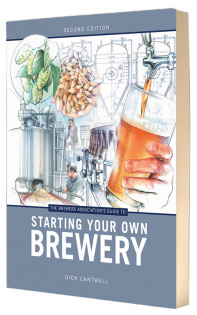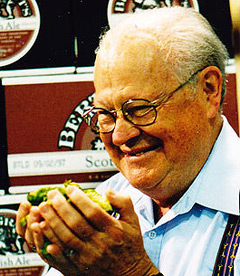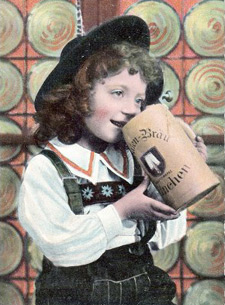 Chuck Lenatti at Allbrews hosts The Session #75: The Business of Brewing. He’s looking for comments and observations from those who have first-hand knowledge about the complexities and pitfalls of starting a commercial brewery.
Chuck Lenatti at Allbrews hosts The Session #75: The Business of Brewing. He’s looking for comments and observations from those who have first-hand knowledge about the complexities and pitfalls of starting a commercial brewery.
Nineteen years ago this week Daria and I sat down at the bar in Armadillo Brewing on Sixth Street in Austin, Texas, and ordered beer. The brewing tanks were right behind the bar, so close that the bartender had to step around the brewer, who was drawing a sample from the mash tun. The brewer proceeded to squeeze an eye dropper of iodine into the sample to see if starches in the grains had converted to sugar (and the wort was ready to boil). Basic homebrewing stuff, but something I’m pretty sure I’ve never seen in a commercial brewery.
But how was the beer? Lousy, but not infected. The guys behind the bar, apparently owners, had a copy of Steve Johnnson’s On Tap: A Field Guide to North American Brewpubs and Craft Breweries in hand and were talking about where they might open their next brewery.
When we checked a year later Armadillo was out of business. Eventually, another owner gave brewing a shot in the same building, opening Katie Bloom’s Irish Pub. That didn’t work, although Katie Bloom’s continued to operate after selling off the brewing equipment. One time when we were in Texas we drove by and the storefront was vacant. Today Pure Ulta Lounge “brings the excitement of Miami’s South Beach” to 419 E. Sixth Street.
The beer was better at the Armadillo than Babe’s: The Brewery in Des Moines, a large downtown restaurant that added a brewery because . . . actually, I’m not quite sure why. Every beer we tried there was buttery, and some of it was sour as well. A pleasant level of diacetyl is one thing. This was something else.
As we admired the duct tape used to repair a tear in the fabric of our booth we listened to a customer at the bar. He was leaving town for an extended trip and talking about how much he’d miss the beer, because he knew he’d find nothing he liked as much while traveling.
 Coincidentally, Babe’s was located at 417 Sixth Avenue. However the lesson here is not to avoid opening a brewery in the 400 block on a Sixth street. It is to know what the hell you are doing and be careful who you listen to. In announcing the topic this month Lenatti wrote, “Making beer is the easy part, building a successful business is hard.” Yes, it’s important to understand that there’s more to the business than brewing beer. But you really need to know how to make great beer, and then to assure it is great clear to the consumer’s glass.
Coincidentally, Babe’s was located at 417 Sixth Avenue. However the lesson here is not to avoid opening a brewery in the 400 block on a Sixth street. It is to know what the hell you are doing and be careful who you listen to. In announcing the topic this month Lenatti wrote, “Making beer is the easy part, building a successful business is hard.” Yes, it’s important to understand that there’s more to the business than brewing beer. But you really need to know how to make great beer, and then to assure it is great clear to the consumer’s glass.
The best advice I can offer somebody thinking about opening a brewery is don’t. But if you must, consider reading The Brewers Association’s Guide to Starting Your Own Brewery (revised edition) before doing anything else. [See disclaimer below.]
The Table of Contents should convince you. The updated version ships in June and both Brewers Publications and Amazon are taking preorders now.
*****
Diclaimer: Brewers Publications published three of my books — For the Love of Hops, Brew Like a Monk, and Brewing With Wheat — so we have something of a relationship.
 UK hop merchant Charles Faram & Co. includes an interesting twist in providing basic information about the hops its sells.
UK hop merchant Charles Faram & Co. includes an interesting twist in providing basic information about the hops its sells. Glenn Humphries at beer is your friend has announced the topic for
Glenn Humphries at beer is your friend has announced the topic for  Why would a German beer drinker pay the equivalent of $4.20 for a 12-ounce bottle of Brooklyn Lager? It’s an excellent beer, but that’s quite a markup over what it costs in the United States and considerably more than Germans pay from any of several outstanding beers.
Why would a German beer drinker pay the equivalent of $4.20 for a 12-ounce bottle of Brooklyn Lager? It’s an excellent beer, but that’s quite a markup over what it costs in the United States and considerably more than Germans pay from any of several outstanding beers.